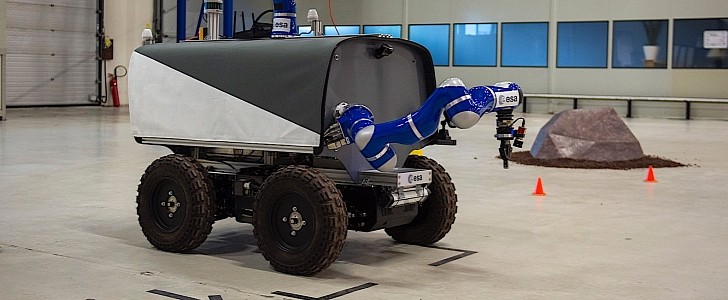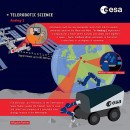By its nature, space exploration requires a lot of remote operation of hardware. Whether we’re talking about satellites in orbit or spacecraft at the edge of the solar system, we’re used to people here on Earth sending commands to objects up there in space and having those react. But for people in space to control something on Earth, well, that’s somewhat rarer.
This week, the European Space Agency announced the publication of a paper in Science Robotics, detailing the experiments that have been going on for some time now, meant to give humans new, more hands-on means of exploring alien worlds.
The paper, called “Exploring planet geology through force-feedback telemanipulation from orbit,” details a new technique that uses said force feedback, a new control interface, and new practices to pretty much make up for limitations of bandwidth, poor lighting, or signal delay.
Developed by ESA, the German Aerospace Center DLR, and other interested European parties, the new process allowed an astronaut, for the first time, “to control a robotic system on the ground in such an immersive, intuitive manner.”
Using a 6 degree of freedom control interface, astronaut Luca Parmitano, located back in 2019 on the International Space Station (ISS), managed to take control of ESA’s Interact rover, located inside a mock lunar environment in Valkenburg, The Netherlands, during a test called Analog-1.
The astronaut was in control of the rover for two hours, during which time he faced, on average, a two-way signal delay of more than 0.8 seconds and a data packet loss rate of over 1 percent, due to the distance between the surface and the station. Yet, the technique allowed him to continue working withouth the risk of damaging the rover.
Further tests of the procedure are to follow and who knows, maybe in the distant future, it could prove invaluable for us humans, as we reach other planets that need to be surveyed more directly before deciding to get down there.
The paper, called “Exploring planet geology through force-feedback telemanipulation from orbit,” details a new technique that uses said force feedback, a new control interface, and new practices to pretty much make up for limitations of bandwidth, poor lighting, or signal delay.
Developed by ESA, the German Aerospace Center DLR, and other interested European parties, the new process allowed an astronaut, for the first time, “to control a robotic system on the ground in such an immersive, intuitive manner.”
Using a 6 degree of freedom control interface, astronaut Luca Parmitano, located back in 2019 on the International Space Station (ISS), managed to take control of ESA’s Interact rover, located inside a mock lunar environment in Valkenburg, The Netherlands, during a test called Analog-1.
The astronaut was in control of the rover for two hours, during which time he faced, on average, a two-way signal delay of more than 0.8 seconds and a data packet loss rate of over 1 percent, due to the distance between the surface and the station. Yet, the technique allowed him to continue working withouth the risk of damaging the rover.
Further tests of the procedure are to follow and who knows, maybe in the distant future, it could prove invaluable for us humans, as we reach other planets that need to be surveyed more directly before deciding to get down there.








